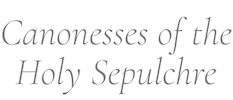Our Archive dates back to the 17th century and is recognised as being of great significance to social and church history. The original books, manuscripts, letters, photographs and artefacts are a vital historical legacy and hold precious memories of those who have gone before us.
In December 2018, we took the momentous decision to move the bulk of our Archive to Durham University where it will be cared for professionally and made accessible to students, researchers and anyone else interested in our history. The collection was packed and moved by specialists and is now being re-catalogued by Durham University Archives and Special Collections ready for future reference and research.
For access and general enquiries, please email pg.library@durham.ac.uk.

Our Archive in Durham
In January 2020, the Community travelled to Durham to meet with academics and other interested parties. They began discussions to explore the significance of their archive and book collection and also the potential of the collections for teaching, research, outreach and visitor engagement purposes.
A rare books cataloguer and a new researcher of the archive have been appointed and are beginning further work on the collection.
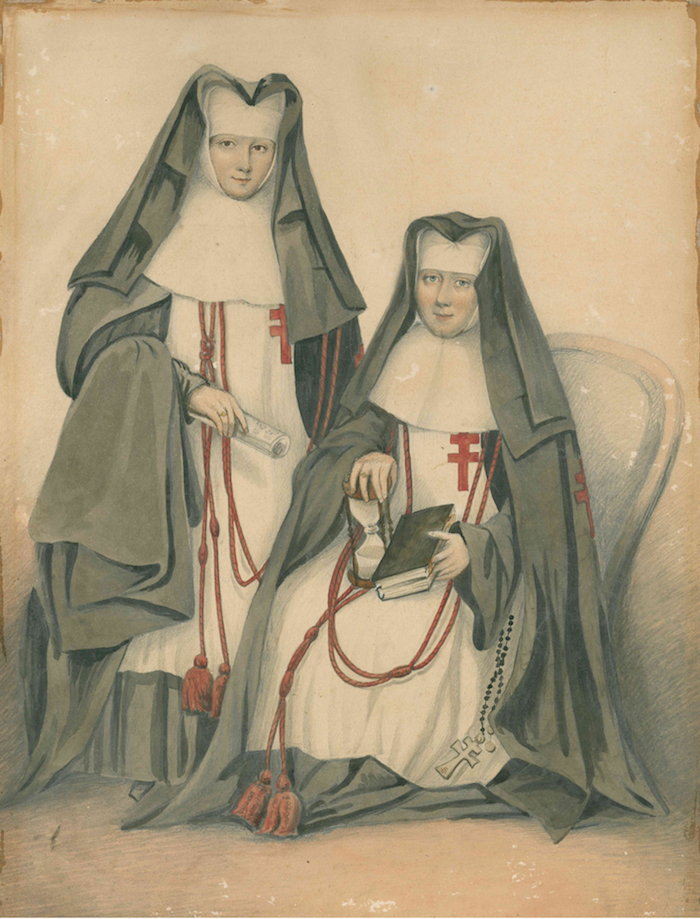

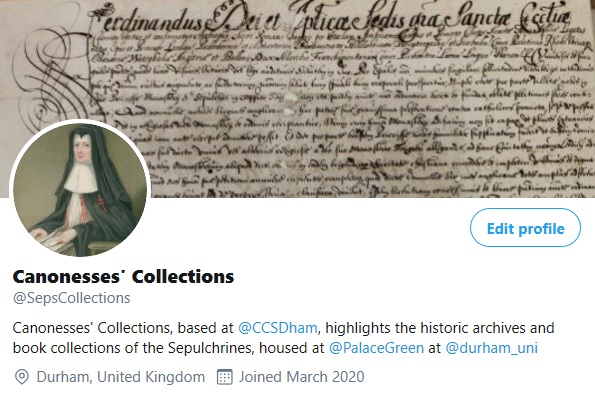
Research Update – March 2020
A tri-party project has commenced, with an archivist and rare-books cataloguer caring for the archives and books, and a historian working on the project’s research element. The historian, Dr Cormac Begadon, has just launched a Twitter page called Canonesses’ Collections. The page will give weekly insights into his research, drawing attention to lesser-known aspects of these historically important collections. There will be insights into the life of the Community whilst at Liège and then at New Hall. You will also hear all about what the sisters were reading, with news from their library. We will be posting some highlights on our website.

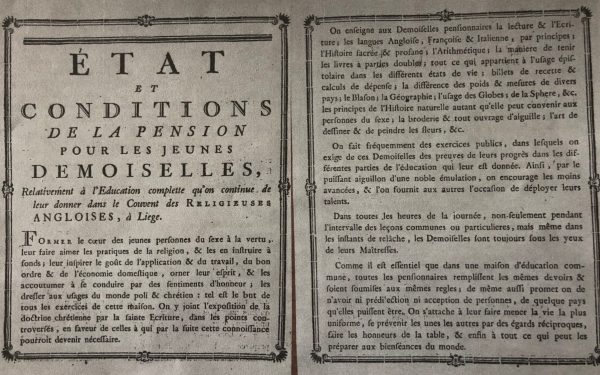
Research Update – June 2020
Recently Dr Cormac Begadon, of Durham University, gave a ‘virtual’ update to the Community. He outlined the various ways in which his research into the history of the Canonesses has been progressing, in spite of the Covid 19-related restrictions. He began his presentation with a brief update on four specific project milestones. The first of these was a piece of particularly good news for all those interested in the history of the Community: the planned publication of the Canonesses’ ‘migration narrative’ from 1794. The story, which retells in such a vivid fashion, the escape and perilous journey of the Canonesses and their companions from Liège to England, will be published to academic standards, but in a manner that will make it accessible to non-specialist readers. Secondly, he brought news of the discovery of a prospectus for the school at Liège, dating from the early 1770s. A very rare example of a printed prospectus for an English Catholic school from this period, he outlined its historical significance and importance to his research. He also spoke about plans for a research workshop on the history of female religious in the early modern period, showcasing the collections of the Canonesses at Durham University. Finally, he mentioned the work of the project’s Twitter page, @sepscollections, which publishes snippets from the collections. He mentioned that the page has received much interest from academics and non-academics, and has been picked up by New Hall School and their alumni. To read more..

CCS Study Series: Hidden Histories
We were delighted to attend Durham University Centre for Catholic Studies two-evening online event in March 2021. The series of talks focussed on the importance of the archives of religious congregations, from the break with Rome to the present day
Dr Cormac Begadon and Dr Hannah Thomas were on the panel of speakers and spoke about the Canonesses of the Holy Sepulchre in the context of their specific areas of research on the Community’s archive. Dr James Kelly chaired both sessions. You can watch the full event below. S. Moira introduces Dr Begadon at 1:00:50 (Part I) and S. Frances Orchard cj introduces Dr Thomas at 00:06:42 (Part 2) of the recording.

From our Archive
Below are some stories and descriptions of items in our archive.
The Secret Cemetery: A Guide to the Burial Ground of the English Canonesses of the Holy Sepulchre in the parishes of Boreham and Springfield, Chelmsford
 The cemetery research project came to an end in July 2017, and we are delighted to announce that Dr Hannah Thomas’s research has now been published and is available for purchase. The book, entitled The Secret Cemetery: A Guide to the Burial Ground of the English Canonesses of the Holy Sepulchre in the parishes of Boreham and Springfield, Chelmsford, published by Gracewing, was launched on 8 October 2017 at New Hall. It includes a history of the Community’s time in Liege from 1642 until 1794, much of which is new information gathered by Hannah and Pauline McAloone during their trip to Liege in 2016. The Community’s journey from Liege to England is also explored, including the burial of deceased Community members in London, Yorkshire and Wiltshire. The book also includes a detailed plan of the cemetery and an index of inscriptions, and the stories of those who are buried there. The book is full illustrated with lovely colour photographs throughout, including lots of items from our archives. It costs £25, (not including postage and packaging which is extra) and can be purchased in our online shop.
The cemetery research project came to an end in July 2017, and we are delighted to announce that Dr Hannah Thomas’s research has now been published and is available for purchase. The book, entitled The Secret Cemetery: A Guide to the Burial Ground of the English Canonesses of the Holy Sepulchre in the parishes of Boreham and Springfield, Chelmsford, published by Gracewing, was launched on 8 October 2017 at New Hall. It includes a history of the Community’s time in Liege from 1642 until 1794, much of which is new information gathered by Hannah and Pauline McAloone during their trip to Liege in 2016. The Community’s journey from Liege to England is also explored, including the burial of deceased Community members in London, Yorkshire and Wiltshire. The book also includes a detailed plan of the cemetery and an index of inscriptions, and the stories of those who are buried there. The book is full illustrated with lovely colour photographs throughout, including lots of items from our archives. It costs £25, (not including postage and packaging which is extra) and can be purchased in our online shop.
Following publication of The Secret Cemetery in October 2017, a document came to light in February 2018 that contained significant additional information, in particular facts pertaining to the date of the building of the wall around the burial site. The following addendum to the book has been written by Dr Hannah Thomas.
Several important traditions were kept in the Community over Christmas and New Year. Christmastide was a time for feasts, putting on plays, recreation and a general relaxing of rules. However, the Divine Office continued to be strictly adhered to throughout.
An extract from the Chantresses Book from 1909 gives a picture of what life was like for the Community at Christmastide.
EXTRACT FROM CHANTRESSES BOOK 1909
Taken from the Community’s ‘Customs’ book is a record of Feast Days kept over the Christmas and New Year period.
Two of the main traditions celebrated are summarised below:
From the ‘Red Book’, which is a history of New Hall Community written for private circulation in 1899, two extracts about the Feast of the Holy Innocents and Kingstide:
Finally, a couple of memories, excerpts from the Community Archives and published in Fishy Tales. The accounts are from two schoolgirls Mary McDonnell (c 1898) and Frances Russell (later to become S. Antony Magdalen), the latter written in reflection when she was in her 90s:
Gardens have been an important part of Community life since the very beginnings.
In Liège we know that the Community grew and sold produce (and animals). Amongst the items listed as sold in the Accounts Book are: flowers, kitchen fat, cows, hogs, and bran. Kitchen fat appears to have been particularly profitable.

Extract of Accounts Book 1775
On the journey from Liège and before the Community settled at New Hall a record of their time at Holme Hall shows the importance of gardens for growing produce and for recreation, which then continued at New Hall.
The chapter in the ‘Red Book’ A History of New Hall (An account of the Migration) gives a great account of the arrival at Holme Hall, a description of the grounds and the Community’s distress about the general condition of the garden:
- The Garden was ‘entirely overgrown with grass and weeds and we were much distressed during the winter for garden stuff as we could not buy any in the neighbourhood’. A Protestant lady who lived 7 miles away heard of our difficulty and sent us a basket of different vegetables every week until we got our own Garden in order. P.134
- ‘One Cow not being enough we bought two’. P134
- There were two Horses, one for Mr. Clifton and one for the Watercarrier, to go to the Post and for other commissions. P.134/135
- Rev. Mother fixed the bounds of our Inclosure, to the garden containing two acres of ground, walled round, 2 large fields which were at the side of the house, the grounds round the house which we had for our own use, a small orchard and a shrubbery, above half a mile long. In the latter we were not to go alone as it was some distance from the house.
The Great Garden, New Hall
At New Hall, ‘The Great Garden’ was used for growing produce for the Community and school. It would appear from the Account Books that garden produce was also sold for profit. S Mary Magdalene tells us this would happen particularly during school holidays when there were less mouths to feed.

Extract from the Account Books
During the 19th and first half of the 20th century, the New Hall farm and the Great Garden provided milk, fruit and vegetables for the whole household. The 1935 Prospectus says: “….Five acres of garden and greenhouses form the source of supply of fruit and vegetables. There is, too, a large apiary providing honey of the best quality. “Since the 1960s, however, it was found to be uneconomic to continue to have staff to run the Great Garden, and after the war there were no more beehives. In the 1950s, the farm was let to the Furze family, but they still produced milk for the household until it was considered necessary in the 1980s to change to pasteurised milk. In 1970, one half of the Great Garden was divided into tennis courts and the other half was the Riding school.
The Twentieth Century – Records of the History of the Community, New Hall
PICTURES OF THE GREAT GARDEN
The “Little Gardens” (or ‘Nuns’ Gardens), New Hall
The ‘Little Gardens’ were used for ‘Recreation’. The Little Gardens were located within the walled garden, next to the Nun’s Quarters. ‘Recreation Days’ were afternoons when there was freedom to speak, read, garden, sew, go for a walk. As opposed to ‘Workroom Days’ when prescribed Community work was to be done, in silence.
The Little Gardens were divided up into smaller areas so each Sister who wished to, could have a small area of their own to cultivate.
PICTURES AND PLAN OF LITTLE GARDENS
The school
An interest in gardens was also encouraged in the children at the school, including the Prep school in Berkshire. There are many lovely photographs of children happily digging and planting with the Sisters!
Turnhout Community in the Congo
From 1928 until the establishment of an independent Congolese Priory, many sisters went from the Priory in Turnhout, Belgium to the Congo to work as missionaries. Among other things they assisted in the construction and development of the African Community of Bukavu (Mirhi).

1956 – Black and white photos of Turnhout sisters in Belgian Congo
Foundation of the Daughters of the Resurrection
In 1966, the Priory of the Daughters of the Resurrection was founded in Bukavu in the South Kivu region of the Democratic Republic of Congo in 1966 by Mère Hadewych Ryckebusch, who was a Sister in the Order of the Holy Sepulchre in Belgium and had been a missionary in the Congo since 1934.
Mère Hadewych lived very closely to what was happening in the country and its consequences – close to the hunger and poverty which devastated the country. She was moved by the poverty of the people, especially the situation of pregnant women who were dying in large numbers just as they were giving birth, because of lack of care.
Every day she saw children dying of hunger and of malnutrition. She saw the lack of knowledge and lack of education as signs of the times which she had to address urgently. She felt compelled to go and see the Archbishop of Bukavu in order to share her concerns and her determination to do something to alleviate this terrible situation. She couldn’t see things continue as they were without finding a solution. The Foundress was inspired by God’s words as she faced this terrible situation: «I tell you, what you do to the least of these my children, you do to me» (Mt, 25, 40). It is these words of Jesus which inspire the basic charism of the Daughters of the Resurrection: «service to the poorest of the poor».
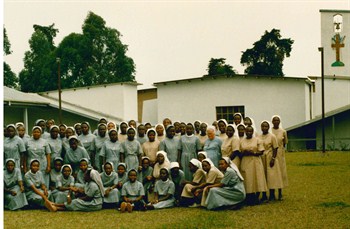
Filles de la Résurrection
Mirhi Priory becomes a member of the Association
In 1984, the Priory of the Resurrection in Mirhi was admitted as a member of the Association of the Canonesses Regular of the Holy Sepulchre.
The main Priory is based in Mirhi, but the sisters, over 200 of them now, work out of smaller houses around the country in order to reach the people who need their help and support. The country continues to be politically unstable and the sisters have witnessed the outcome of many atrocities particularly in the war-torn eastern part of the country. They continue to support local people, especially women and chidren.
The Priory in Rwanda was started by the Mirhi Community before gaining its independence in 2011. The Community at Kindu in DRC established in 2013 is also working to become an autonomous Priory in the near future in the service of the local people.
English Community’s link with DR Congo
It was really only in the late 1980s, after the Priory of the Resurrection in Mirhi-Bukavu (in 1984) was admitted into the Association that the English Community began to have a more direct link with the African sisters. As well as relationships which were strengthened by reciprocal visits between the two Communities, New Hall School also began to forge links with the Congo at this time and have continued their connection through twinning of schools and fundraising for projects such as the Nutritional Centre.

S. Christine, S. Margaret Helen, S. Anne Marie in 1984
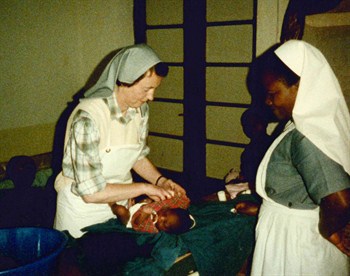
S. Mary Gabriel visiting Zaire (Congo) in 1989
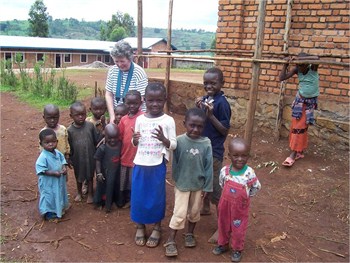
S. Moira’s visit in 2012

S. Margaret Mary (in her role as Prioress General of the Association) with S. Petronella at the
50 year celebrations in DR Congo August 2016
The Journey from Liège to England
Just as religious intolerance in England gave birth to the Community in Liège back in 1642 so it forced the Community to make their way back over the Channel when revolutionary fervour swept through France and the Low Countries at the end of the 18th Century.
In February 1790 the revolutionary National Assembly of France, fearful that the Church held too much power, dissolved all religious convents and monasteries in an attempt to suppress monastic vows and Religious Orders.
Bill of Carriage of the Community’s effects on the “Smallbridge”

In our archives is this doll, dressed in the habit of a Canoness of the Holy Sepulchre as it was worn from our foundation until the mid 20th century.
You can just see the foot of the double red cross on her cloak peeping out from the right of the picture but the red cross on her surplice is completely hidden. If you click here there is a book illustration dating from the very beginnings of our Community showing this habit – with the crosses clearly to be seen.
The purpose of such a ‘doll’ was to act as a kind of model to ensure that the details of the habit did not change over time!

A small folder in the Archive charts the history of the Great Clock which the Community brought with them to New Hall from Liège. It has 4 bells, 2 from Liège and 2 added later. The clock is unusual as it strikes every 7½ mins and on the half hour announces the coming hour.
To read more
Photographs of the Great Clock
The Great Bell
Also recorded in the Archive is the purchase of the Great Bell, installed in 1844 at New Hall above the Chapel. The bell was christened ‘Elizabeth’ in honour of Rev M Regis, whose family donated the money to buy the bell for the Community. After a period of silence the bell has recently started to be rung again.
To read more
Extract from the Chantress Book 1940
Extract from New Hall Magazine, an account of the evacuation to Newnham Paddox written by S. Margaret Helen on 27 February 1990.
Fishy Tales
More interesting accounts of life at Newnham Paddox can be found in the 1940s Chapter of FishyTales – Living Memories of New Hall 1930 – 2012.
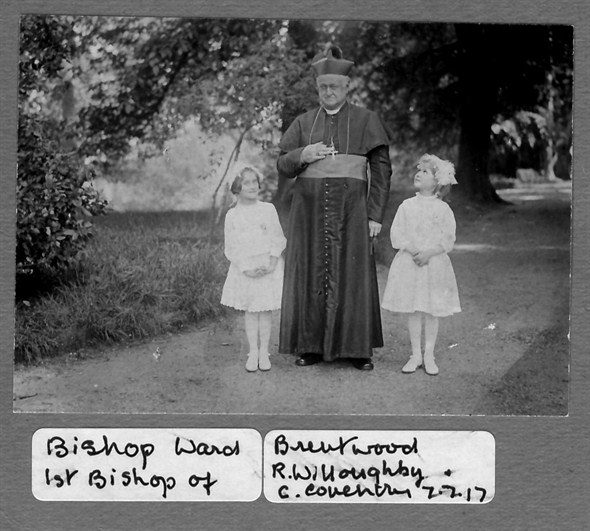
Bishop Ward and two ‘Fishes’
As the Centenary celebrations for the Diocese of Brentwood begin (2017), it is perhaps of interest to share some of our Archive records of this time. The creation of the Diocese of Brentwood in 1917 represented a big change for the Community and School resident in the area since 1799 and formerly in the Diocese of Westminster since its formation in 1850.
The Chantresses’ book of the time records an early visit to New Hall from the first Bishop on 6th June 1917. ‘Bishop Ward came for the night. Children and nuns met him in front of the house at 7 o’clock. Molly Carey read the address and Mary Jackson presented him with a New Hall Book.’
Some further extracts concerning the creation of the Diocese of Brentwood as documented in our Archives:
EXTRACT FROM THE TWENTIETH CENTURY RECORDS OF THE HISTORY OF THE COMMUNITY, NEW HALL
EXTRACT FROM NEW HALL AND ITS SCHOOL (Author: Tony Tuckwell)

This summer the cemetery research project comes to an end, after nearly 3 years of intensive research conducted by Dr Hannah Thomas. Hannah’s research took her deep into the Community’s archives and revealed much more than a few headstones! It is now thought that the Community cemetery is likely to be the oldest Catholic cemetery in continuous use in England and Wales, having been used continuously since March 1799.
The project culminates in the publication of Hannah’s research in a book entitled The Secret Cemetery: A Guide to the Burial Ground of the English Canonesses of the Holy Sepulchre in the parishes of Boreham and Springfield, Chelmsford, available to purchase in October 2017.
Here are a few images taken from Hannah’s book:

Eight members of the Community died during their search for a permanent residence in England, and were buried in four separate locations.
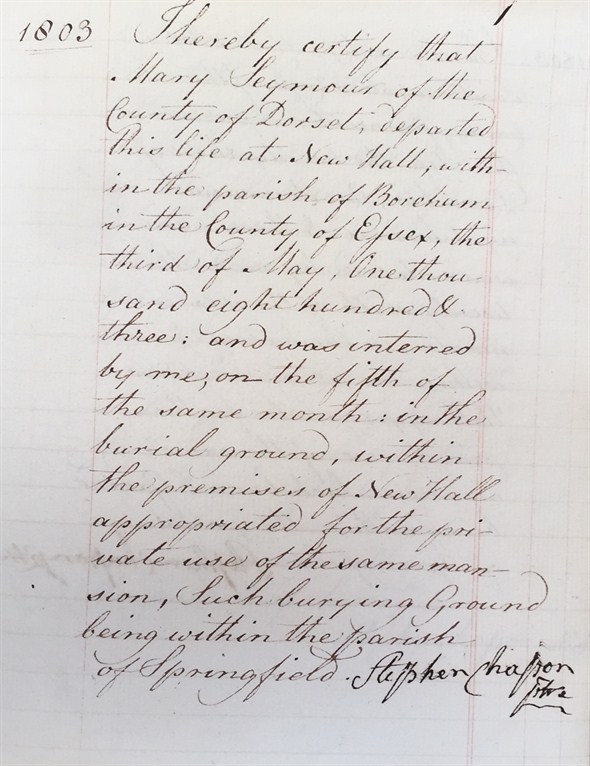
The first entry in the Burial Register dates from May 1803. The earliest entries were probably recorded retrospectively sometime after 1812 in line with the Parochial Registers Act (52 Geo 3 Cap 146) of that year.
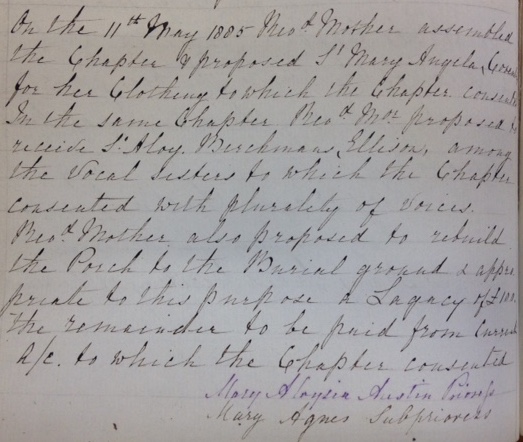
The only reference to the construction of the cemetery, from the Community’s Chapter Book. It records that ‘on 11 May 1885 … Reverend Mother proposed to rebuild the porch to the burial ground and appropriate to this purpose a legacy of £100.’
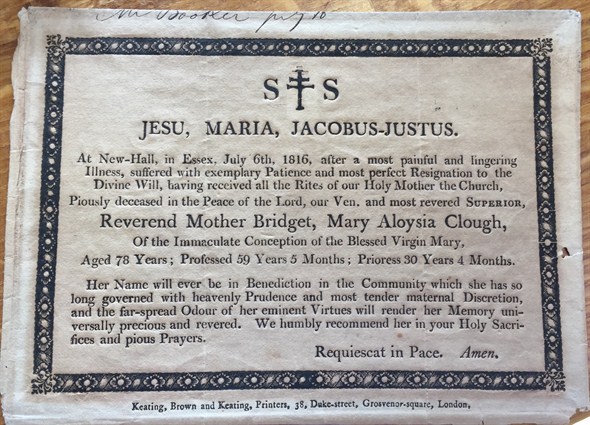
Printed death notice announcing the death of Prioress Mary Aloysia, Bridget Clough (1739-1816) in 1816
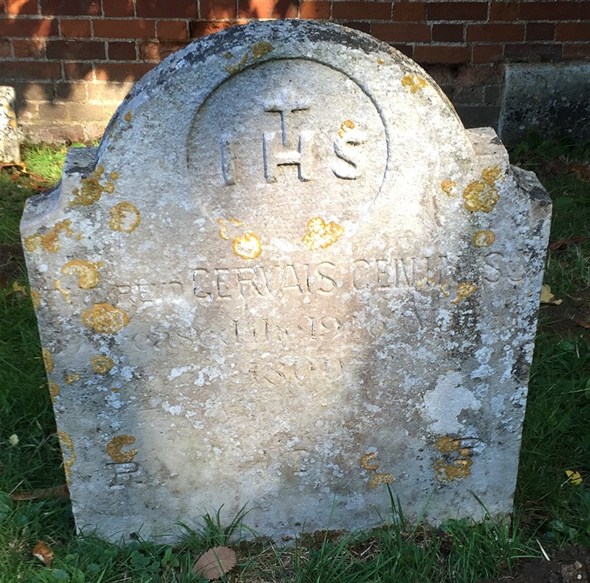
Headstone of Fr Gervais Genin, a French Jesuit who had travelled with the Community from Liège. He was the first clergyman to be buried in the cemetery. The headstone is inscribed ‘The Revd Gervais Genin SJ, deceased 19 March 1800, R.I.P.’
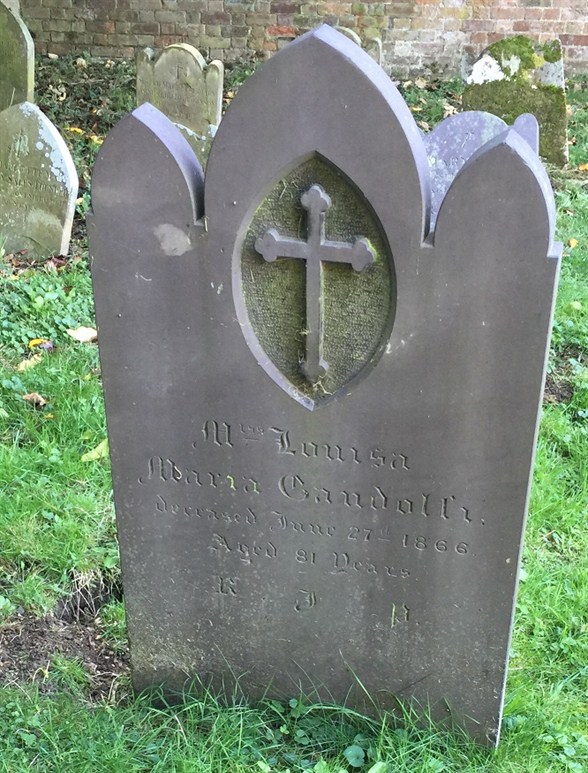
Headstone of Louisa Gandolfi (1785-1866), a lay person who joined the school and remained on as a fee-paying boarder until her death.
The connections between the Community and ancient Catholic families are, unsurprisingly, strong. Some of those links still exist today, for example, with the Petre family.
Four Petres were Canonesses in exile in Liège and one professed at New Hall. There were 26 Petre girls who attended the Community’s school from 1799 through to the end of the 20th century.

S.M Teresa (Gertrude) Petre, 1878-1934

Lord Petre (18th Baron) in 2013 – Thanksgiving Service for Community’s 370th anniversary
Canonesses
There were four Petre sisters, daughters of William Petre and Penelope Wolfe from Bellhouse Essex, who were professed in succession as English Canonesses of the Holy Sepulchre: Bridget, Mary, Penelope and Winefride. They became, S. Mary Bridget, S. Mary Agnes, S. Mary Stanislaus, S. Mary Clare respectively.
It was necessary for the Community to gain special permission from the Prince Bishop of Liège in order for the third and fourth sisters to be professed. The condition was that no more than two sisters could have voice in the Chapter at any one time.
Another member of the Petre family, Gertrude, was professed at New Hall in 1878 as S. Mary Teresa. She died in 1934 and is buried in the cemetery at New Hall.
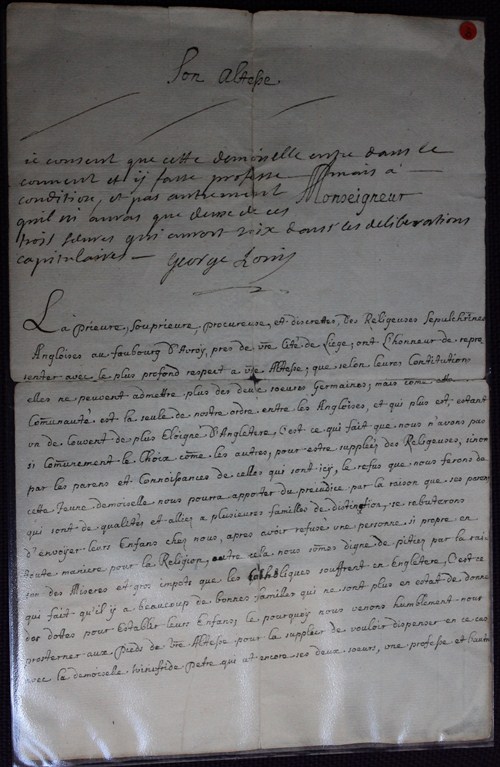
Petition to allow Winifred Petre to enter Community c. 1726
Benefactors
The Community’s accounts show that the Petre family were generous benefactors of the Community over many years. Here is an example from the ‘Red Book’ – History of the New Hall Community 1899.
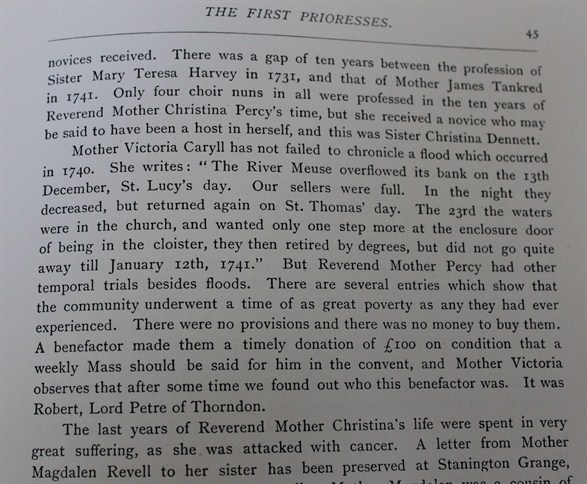
Example of Benefaction from the Petre family
LORD PETRE AND CLARE PETRE WITH THE COMMUNITY IN 1992
– with archives documents pertaining to the family
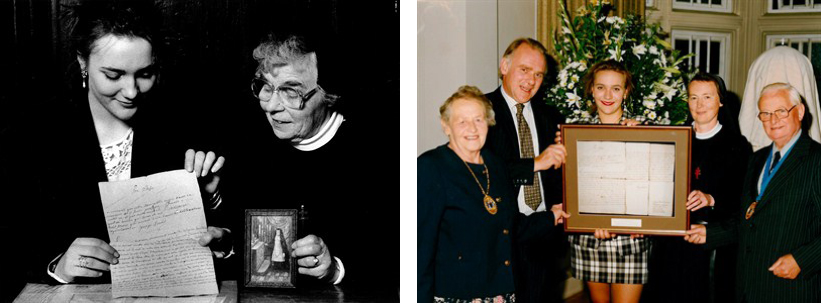
PETRES BURIED IN THE CEMETERY AT NEW HALL
Community – Mary Teresa / GERTRUDE PETRE / deceased 7th June 1934 Sister Mary Teresa
Lay people: ROSAMOND / WHATELEY / nee PETRE died 1990

Lord Petre studying new Cemetery Plan at ‘Secret Cemetery’ book launch – 8th October 2017 (375th anniversary since Foundation of the Community)

In our Archive is a collection of books called the ‘Liège library’. The books belonged to our Community when they were living in Liège. They were brought to England when the Community fled from Belgium in 1794.
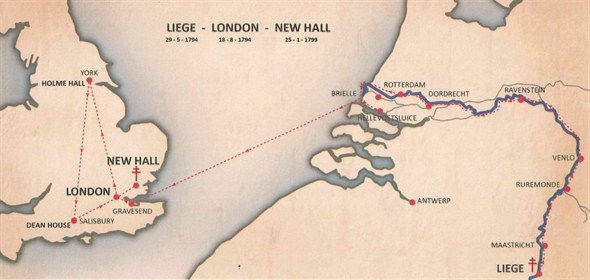
49 nuns, 2 priests, 18 boarders – servants – pensioners
Luggage 800 packages
Landed at Greenwich 18th August 1794
Founded in 1642, the English Canonesses remained in Liège until 1794. By the end of the 18th century the Community was well established in Liège, with a highly respected school.
In the 1790s, as a result of a sudden shift in the political climate in Belgium, following the French Revolution, it became very difficult and dangerous for the Community to stay in Liège. The Community began to make plans to leave.
In 1793 France declared war with England. It was no longer safe for the English Community to remain in mainland Europe and so in 1794 they began a dangerous and eventful journey, on coal barges to the coast and then sailing vessel across the Channel, to England.
Amongst the items the sisters took with them was their collection of books, which forms what we now call the Liège library.
Original wooden chests brought from Liège
In advance of the move from Liège, several hundred portable wooden chests had been commissioned from a local carpenter for the easy transportation of books, archives and other precious items. As well as the books and archive documents, the Community are still in possession of several of these wooden chests.
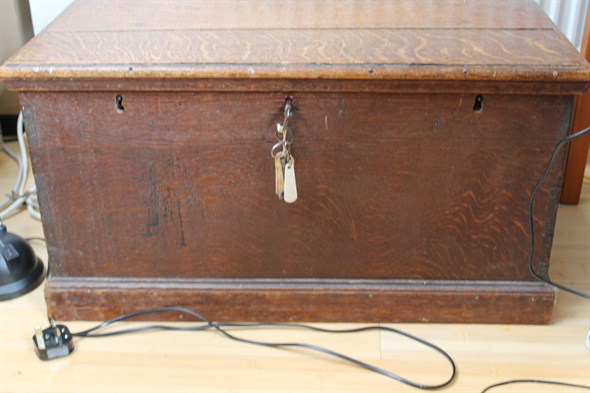

Liège Library
Most of the books in the ‘Liège library’, particularly the earlier dated books, are spiritual exercises and meditations, Lives of the Saints and other religious texts, but there are also history books and literary works such as an Italian translation of Milton’s Paradise Lost, Bunyan’s Pilgrims Progress, Latin grammar and Dictionary of the English language – some marked for ‘use in the school’.
Others have handwritten dedications, signatures of members of the Community and occasionally notes written in the margins of the text.
Here are a few examples from this rare collection.
HISTOIRE DES ORDRES RELIGIEUX – 1695
Engravings by Adrien Schoonenbeek
Published in Amsterdam
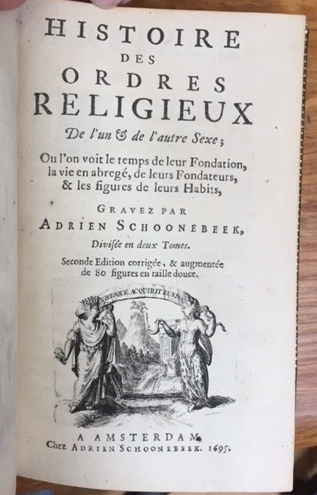
Ref 243: Histoire des Ordres Réligieux
The book shown above is one of two volumes on the history of Religious Orders. The first volume details Orders of male religious and the second volume, shown below, gives a short description of women religious. The two volumes are written in French and they have their original bindings, with gold edging.
COURTE DESCRIPTION DES ORDRES DES FEMMES ET FILLES RELIGIEUSES – 1695
Engravings by Adrien Schoonenbeek
Published in Amsterdam

Ref 244: Courte déscription des ordres des femmes
This second volume is about women religious. It is a small leather bound book, with beautiful engravings, a short description of the Order, stating foundation dates and giving details of clothing and Rule followed. The above shows an illustration of a French Canoness of the Holy Sepulchre.
OFFICIUM DIVINUM SIVE COMMEMORATIO HEBDOMADARIA DE SANCTISSIMO EUCHARISTIAE SACRAMENTO – 1756
Author: Joannis-Theodori, Bavaria

Ref 333: Officium Divinum (cover with clasp)
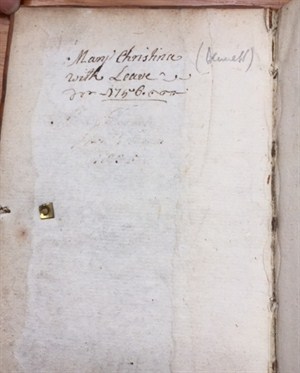
Ref 333: Officium Divinum (inside cover)
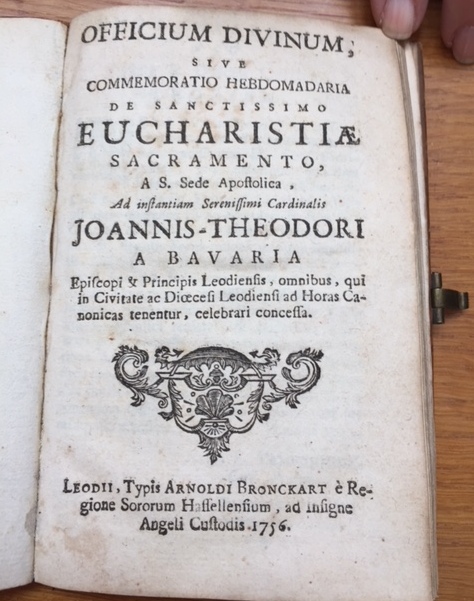
Ref: 333 Officium Divinum – title/author
The Divine Office – printed in Latin. A thin, leather-bound book with a clasp, belonging to S. Christina Dennett. It is dated 1756. There is another handwritten note in the book to say it was lent to S. Aloysia Magdalene in 1891.
THE LIFE OF ST FRANCIS XAVIER OF THE SOCIETY OF JESUS – 1688
Author: Fr Dominick Bohours
Translated by: Mr Dryden
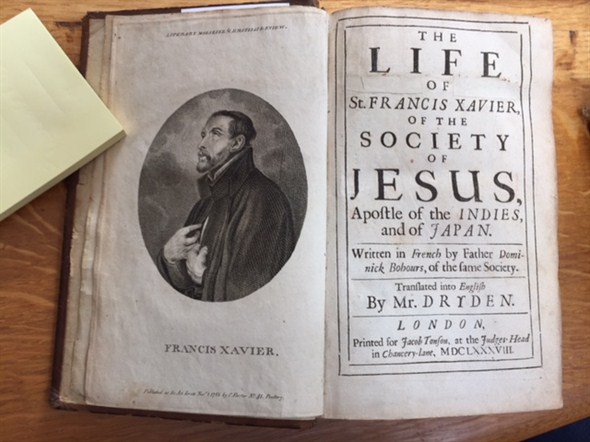
Ref 211: The Life of St Francis Xavier 1688
One of three copies, this is an account of the life of St Francis Xavier of the Society of Jesus. The book is a translation of the original French version. It includes a pull-out map, shown below.
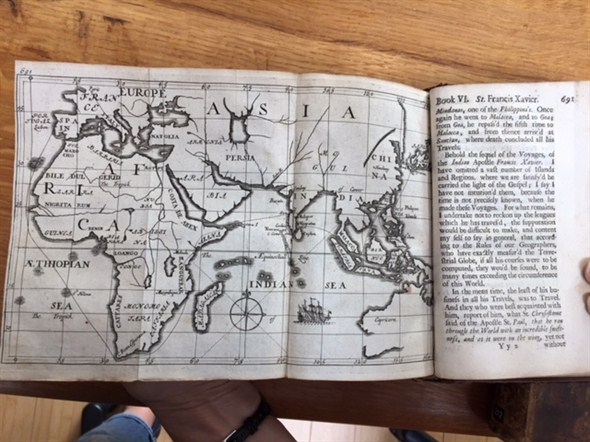
Ref 211: The Life of St Francis Xavier 1688 (pull out map)
THE SPIRITUAL EXERCISES OF S. IGNATIUS OF LOYOLA – 1736
Printed by Nicolas Joseph Le Febvre
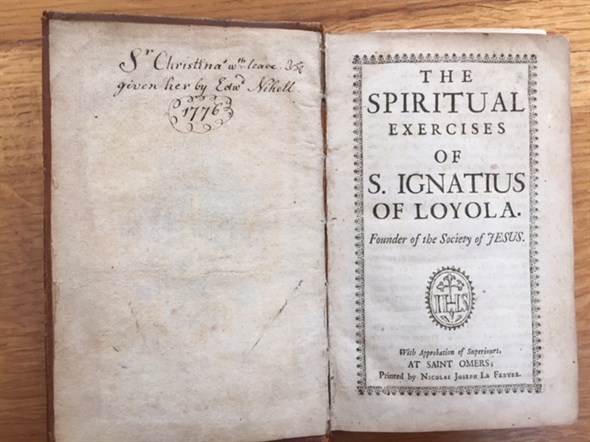
Ref 291: The Spiritual Exercise of S. Ignatius of Loyola
An inscription in the front of the book reads ‘ Sr Christina’s with leave given her by Edward Nihell 1776’. It is written in English and is still in its original binding. It belonged to S. Christina Dennett (who developed the Community’s school in Liège). See handwriting on left hand page above.
ENTERTAINMENTS FOR LENT – 1682
Written in French by the R.F.N. Causin, S. I.
And translated into English by Sir B. B.
Printed for John Williams, and are to be sold by R Moore, 1682
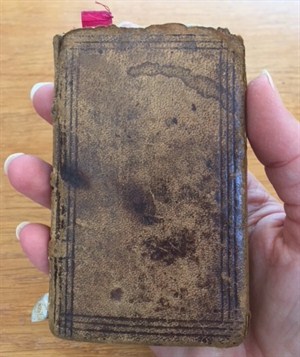
Ref 172: Entertainments for Lent
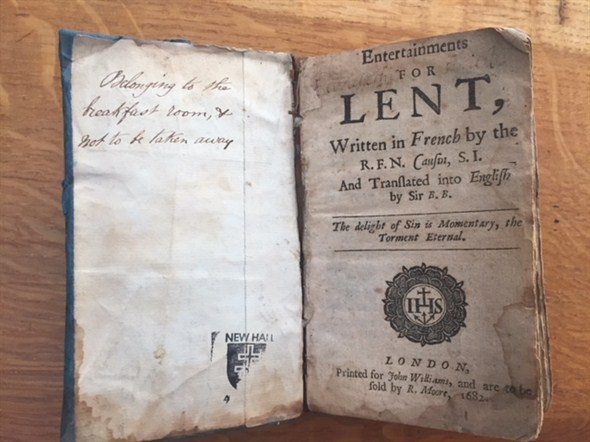
Ref 172: Inside cover is written ‘Belonging to the breakfast room, and not to be taken away’
ABREGE’ CURIEUX ET NOUVEAU DE L’HISTOIRE DE LIEGE DE LA VIE DE S. LAMBERT ET DE S. HUBERT – 1693
Dédié au Peuple Liégeois, A Liège
Chez Henry Hoyoux plse des PP Jésuites a S. François Xavier 1693

Ref 240 : L’Histoire de Liège (cover)
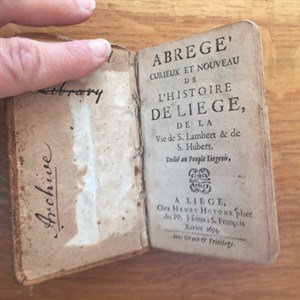
Ref 240 : L’Histoire de Liège (inside cover)
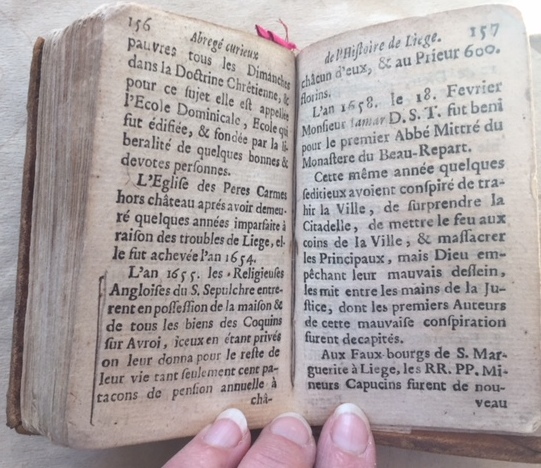
Ref 240: l’Histoire de Liège page 156
This tiny book, which fits in the palm of your hand, gives a short history of Liège on 160 pages. The Community is mentioned within the text and it records that they took over the Coquin monastery in 1655 on Rue St Gilles, in the Faubourg d’Avroy. This was the English Community’s third and final home in Liège, where they lived for almost 140 years, establishing their convent and school which became well renowned.
Earlier in the text, shown below on page 145, it incorrectly states that the English Community (Holy Sepulchre) came to Liège in 1616. As the Order of the English Canonesses of the Holy Sepulchre was founded in 1642 this is clearly an error and as happened on several occasions, there appears to be confusion between the Canonesses and the Mary Ward sisters, so-called Jesuitesses Anglaises, who did indeed set up a house in Liège in 1616. We know that the Canonesses had a connection with the Mary Ward sisters in Liège and it was their house in la Pierreuse which the Canonesses took over in 1644, before moving to Rue St Gilles in the Faubourg d’Avroy.

IL PARADISO PERDUTO
John Milton
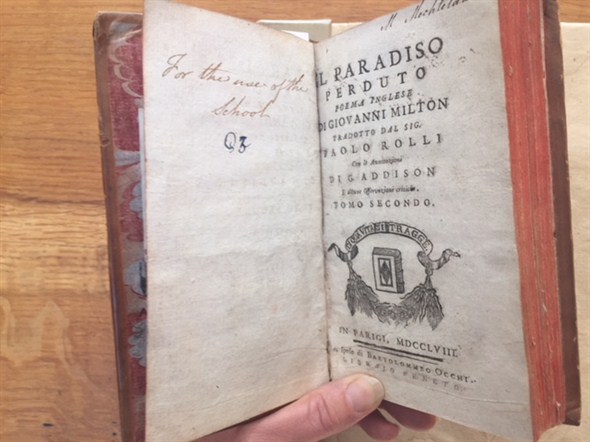
An Italian translation of Milton’s epic poem Paradise Lost. This version was printed in 1758 and an inscription on the inside cover tells us that it was ‘for the use of the school’.
In December 2018, a team from Durham University arrived to help pack and move our Archives. Many of the Community were involved in the preparation for the move.
The documents we have entrusted into the University’s care tell the story of life in the Community, our traditions and charism which have been lived out since that small group gathered in Liège for the foundation of our Community on 8th October 1642. We know the archive is in safe hands and we look forward to a continuing relationship with Durham.
To see some photographs of the Community preparing for the move to Durham, please click on the link below:
One hundred years ago on 28th June 1919 the peace document which officially ended the First World War, the ‘Treaty of Versailles’, was signed.
One of the very first New Hall school magazines written in 1919 “for private circulation” recounts the event from the perspective of the pupils (so-called ‘fishes’) and Community. A tennis tournament was taking place, when the news broke…


School magazine “Fishes Pool” article 1919

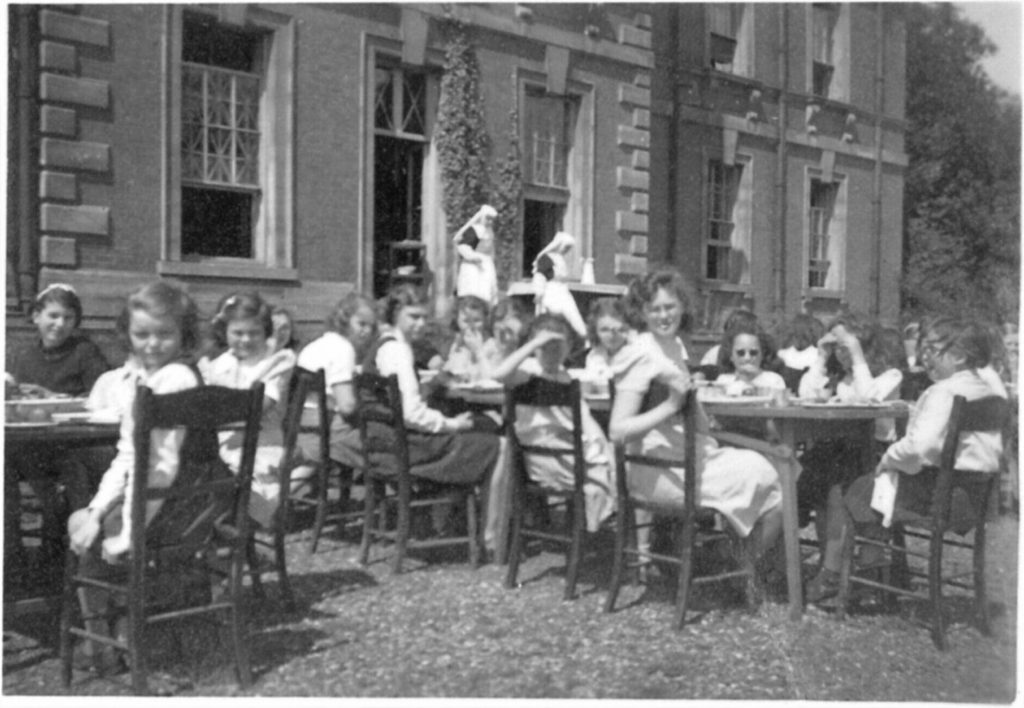
“All I can remember is having a good lunch al fresco prepared by the lay sisters who enjoyed it as much as we did. Then an enormous bonfire in front of the house which as it got darker was illuminated by all the lights being turned on for the first time most of us could remember, I think we had a holiday too!”
– S Mary Magdalene, on the occasion of the 75th anniversary of V E Day – during the Coronavirus lockdown
Several of our Community remember the party at Newnham Paddox, where the Community and school were evacuated in 1940 until 1946. They, and other “Old Fishes”, recount their memories in Fishy Tales – Memories of New Hall 1930 – 2012.
If you would like a copy of the book please see https://canonesses.co.uk/contacts/our-shop/
Here are some of those memories:
“Sudden darkness shocked us one evening. A plane had flown into the power lines. Later we knew Fr Butler had gone over to the crash-site. There were exceptional evenings, when the school was allowed to listen to Churchill making a speech to the nation. Then came V.E. Day and a mighty celebration bonfire, which S.M.Benedict and S.M.Ignatius stoked wearing their gas masks and ARP tin helmets.”
“On V.E. Day we had a festive meal out on the terrace and in the evening a magnificent bonfire in front of the house.
When we returned to New Hall after the war I was very doubtful of how I would survive with all that freedom gone. But by that time I was in the last year of School Certificate and so was well focused in the direction of work.
No one had been able to go home for half-terms during wartime but now they went as before, and only a few of us stayed. We enjoyed the time so much that we resented the return of everyone else! School – including all the Community members we knew – had become more family than home for me, and I was desperately sad to leave and go on to university.”
“On V.E. Day we spent all day collecting twigs and branches and anything that would burn. Then in the dark, with as many of us as possible wearing some blue (with our red uniform and white shirts, making patriotic colours), we watched as Percy Sygrove set our huge bonfire alight. A small plane put the jewel in the crown as it flew overhead and dipped its wings. We jumped up and down waving. ‘Thank you! Thank you!’ we yelled as it flew off into a night filled with lights and hope.”
“On V.E. Day a huge bonfire was lit in front of the grand gates, which we had to watch out of the dormitory window. Every time an aeroplane flew over a great roar of joy broke out among the Fishes gathered round the fire.”
“On V.E. Day we had a huge bonfire in front of the house. The young nuns S.M.Christopher, S.M.Peter, S.M.Martha and S.M.Benedict – and probably also Magdalen John, helped to build it. It was at night, and amazingly exciting – all the more so when an aeroplane flying over dipped its wings.”
See below archive photographs of Newnham Paddox, Rugby and for Chantress’ Book account of the decision to evacuate school and Community see Archives/WWII Evacuation.

